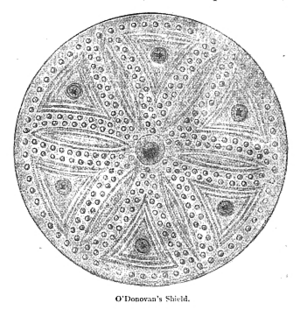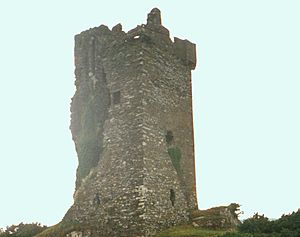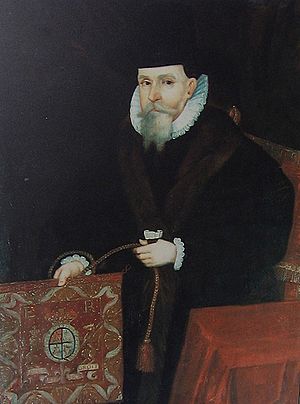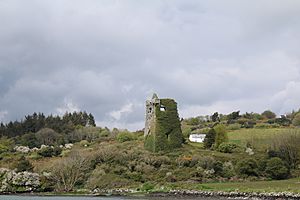Donal II O'Donovan facts for kids
Quick facts for kids
Domhnall II Ó Donnabháin
|
|
|---|---|
| Lord of Clancahill, The O'Donovan | |
 |
|
| Born | circa 1560, Castle Donovan |
| Died | 1639, Rahine Manor |
| Buried | Timoleague Abbey |
| Family | O'Donovan |
| Father | Donal of the Skins |
| Mother | Ellen O'Leary |
Donal II O'Donovan (Irish: Domhnall Ó Donnabháin) was an important Irish leader. He was known as The O'Donovan of Clann Cathail and Lord of Clancahill. He was born around 1560 at Castle Donovan and passed away in 1639. His parents were Ellen O'Leary and Donal of the Skins. People at the time often called him Donnell O'Donevane of Castledonovan.
Donal became the leader of his family, Clan Cathail, after his father died. His father-in-law, Owen MacCarthy Reagh, Prince of Carbery, officially made him leader in 1584. This was done in an old Irish way, where he received a special staff called the White Rod. Later, in 1592, a powerful English official named Lord Chancellor Loftus also recognized him as the rightful leader. Donal was the last O'Donovan leader to be chosen in this traditional Irish way.
During the Nine Years' War, Donal supported Philip III of Spain. But in 1608, he gave his lands to James I of England. He then got them back as his own personal property in 1615. Records from 1599 to 1636 show that Donal had some of the largest land holdings in Carbery.
Contents
Becoming a Leader and a Lawsuit
Donal II became a leader in 1584. His father-in-law, Owen MacCarthy Reagh, 12th Prince of Carbery, helped him. This was confirmed in a lawsuit started by Donal's younger brother, Teige, before 1592. Teige claimed that Donal was not the rightful leader.
Teige said that Donal was born before his parents, Donal I and Ellen O'Leary, were married. This would have made Donal "illegitimate" (meaning not recognized as a legal heir). Teige even questioned if Donal was his father's son at all. He also said that Donal owed his position to Owen MacCarthy Reagh, who was very rich and powerful. Teige even claimed Owen himself was not the true Prince of Carbery.
However, Lord Chancellor Loftus decided in favor of Donal II O'Donovan and Owen MacCarthy Reagh. He said they were both legitimate and rightful leaders. Teige's claims were rejected. Another important person, Sir Fineen O'Driscoll, who was popular with the English, also supported Donal. He said Donal was born many years after his parents were married.
Historians often talk about this case. It shows that the O'Donovans were seen as one of the four most important families in Carbery. This is because Donal received the White Rod (or slat). This rod was a symbol of a king or important leader in ancient Ireland. Donal was a local lord, receiving his rod from his superior, MacCarthy Reagh. This was also one of the last times the slat was used in Irish history. It showed that it was still a strong symbol of rightful authority. The O'Donovan family also had a special position. They paid less rent to their superior than other leading families. This might be because of their strong support for Fínghin Mac Carthaigh in the 13th century. They helped him at the Battle of Callann in 1261.
Donal II was the last O'Donovan leader to receive the white rod. Even though the English government tried to stop the use of old Irish titles, Loftus still called Donal "O'Donovan." This meant he was recognized as the main leader of his family, or Chief of the Name. By recognizing Donal as the "Chief," the English government made sure he had the power to give about 60,000 acres of clan lands to the English Crown. Donal then got these lands back as his own personal property.
Donal's Life and Actions
Donal II O'Donovan is first mentioned in 1586. He burned down the new house of the Protestant Bishop of Cork, Cloyne and Ross, William Lyon. The bishop's house was very fancy. Lyon was also accused of stealing valuable church items. Donal might have even burned the town of Rosscarbery itself. His men may have killed one of Lyon's daughters during the attack. Bishop Lyon later wrote in 1615:
My house was burned by one Donovan, a neighbour in wild rebellion. He destroyed the glass windows of the church, took the lead off, pulled down the Queen's arms then standing over the gate of my house and trod them under-foot.
Donal II was active in Munster during the Nine Years' War. He was one of the few southern lords to support Hugh O'Neill. In March 1599, most lords in Carbery promised loyalty to the English Crown. But O'Donovan and some MacCarthys did not. Because of this, Sir Thomas Norris attacked their castles and lands.
A year later, O'Neill was seen as the virtual King of Ireland. Many leaders, including O'Donovan, supported him. Those who refused had their lands destroyed. In late 1599, Donal joined Florence MacCarthy and Owen Mac Egan. They wrote a letter asking Donogh Moyle MacCarthy to join them. This letter was caught. English forces under Captain George Flower then attacked Donal's people. Flower wrote about burning their lands and killing many people and animals.
Later, when Philip III of Spain sent forces to Munster, 100 men were assigned to Donal. They were fully equipped and paid. He was also one of the main leaders in the army led by Donal Cam O'Sullivan Beare. This army went to help Pedro de Zubiaur at Castlehaven in December 1601. According to some accounts, this led to a small victory for the Spanish and Irish.
After the war, Donal changed his loyalty and sided with the English. Donal Cam O'Sullivan Beare then attacked Donal's lands. Later, some of Donal's men killed Dermod Maol MacCarthy. Dermod was seen as a threat to the English. Donal remained loyal to the English, even though some of his own family members supported the rebels.
In 1606, Donell M'Carthy asked that Donell O'Donevan pay him for damages. Donell M'Carthy's son had been held prisoner for four and a half years because Donal O'Donovan was supposed to be loyal. In the old Irish system, children were sometimes held as guarantees for a leader's good behavior.
Donal's Lands and Castles

After the war, Donal O'Donovan did very well. He gained control of more lands. This happened because the government gave him lands taken from other families. He also worked hard to expand his holdings. In 1599, his lands were described as 67 "ploughlands." A ploughland was an old way to measure land, about 120 acres. Two of these were for the church.
These lands covered most of the modern areas of Drimoleague, Drinagh, and Myross. Donal had three castles on these lands: Castle Donovan (Sowagh), Rahine (Raheen), and Castle Ire (Ivor). Castle Donovan was in Drimoleague, and the other two were in Myross. Myross was once home to a Norman castle. It is believed that a big battle happened nearby in 1326. The O'Donovans were likely there, helping the MacCarthys win.
Rahine and Castle Donovan were probably built by the same people who built the O'Leary castle of Carrignacurra. They used new designs in the late 1500s. Castle Ire was simpler. It is believed that all these castles were built during Donal's time.
In 1611, Florence MacCarthy accused Donal of taking some of his lands. Florence was being held in the Tower of London at the time. Not much is known about Donal II's later life until his death in 1639. He was quite old by then. The Manor of Bawnlahan stayed in the family until Richard II O'Donovan died. After that, the descendants of Teige, Donal II's son, became the O'Donovan leaders. They built a grand house called Lissard. Later, they sold Lissard and moved to Hollybrook House, near Skibbereen.
A Musician in Donal's Home
A blind harper named Conchubhar Mac Conghalaigh lived in Donal's home. A poet named Tadhg Olltach Ó an Cháinte wrote a sad poem for him called Torchoir ceól Cloinne Cathoil. The poem mentions Donal and his wife, Lady Joanna. It describes her sadness for the harper. The 12th verse says:
Sorrowful for her blind darling
is the daughter of Eóghan son of Domhnall;
her sigh is senseless as a burden;
this lady of Clann Charrthaigh is distress to my heart.
The poem also mentions Dáire Cerbba, an ancestor from the 4th century. The O'Donovans are related to him.
Family Life
Donal O'Donovan married twice. His first wife was Helena de Barry. They had four sons:
- 1) Donal III O'Donovan
- 2) Conogher, who joined the Austrian Army and never came back to Ireland.
- 3) and 4) Possibly two other sons.
His second wife was Joanna MacCarthy Reagh. They had six sons:
- 1) Teige, who later became important in the family line.
- 2) Captain Murrough, a royalist soldier who died in the Battle of Rathmines.
- 3) Donough
- 4) Dermot
- 5) Captain Richard, a royalist soldier who died in another country.
- 6) Keadagh
Donal and Joanna also had three daughters:
- 1) Honora, who became the second wife of Teige-an-Duna MacCarthy.
- 2) Married a MacCarthy of Mourne.
- 3) Married an O'Mahony Fionn.
Donal's eldest son, Donal III, continued the main family line. Later, after General Richard II O'Donovan died in 1829, the leadership passed to the family line of Teige, Donal II's son from his second marriage. This line still holds the title today. A notable descendant from Teige's line is Morgan Wiliam II.
The famous scholar John O'Donovan claimed to be a descendant of Donal II. He first said his ancestor was the eldest son. After many years of research, he changed his claim to say his ancestor was the youngest son of Donal II.
See also
- Chief of the Name
- Surrender and regrant
- Gaelic Ireland
- Gaelic nobility of Ireland




